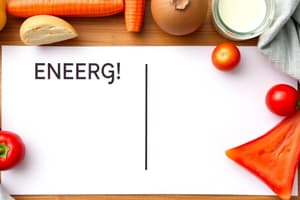Podcast
Questions and Answers
What is a calorie?
What is a calorie?
- A unit of measure for energy produced by foods (correct)
- A measure of weight
- A type of exercise
- A vitamin
What does Kcal stand for?
What does Kcal stand for?
Kilocalorie
Energy balance occurs when energy intake equals energy expenditure.
Energy balance occurs when energy intake equals energy expenditure.
True (A)
What happens during positive energy balance?
What happens during positive energy balance?
What occurs during negative energy balance?
What occurs during negative energy balance?
What is hunger?
What is hunger?
What are hunger triggers?
What are hunger triggers?
What is appetite?
What is appetite?
Define satiety.
Define satiety.
What are some satiety triggers?
What are some satiety triggers?
What sends hunger and satiety signals in the brain?
What sends hunger and satiety signals in the brain?
What is gastric stretching?
What is gastric stretching?
What role do gastrointestinal hormones play?
What role do gastrointestinal hormones play?
What does Ghrelin do?
What does Ghrelin do?
What does CCK do?
What does CCK do?
What components make up Total Energy Expenditure (TEE)?
What components make up Total Energy Expenditure (TEE)?
What is basal metabolism?
What is basal metabolism?
What is the energy required for physical activity?
What is the energy required for physical activity?
What does the thermic effect of food (TEF) represent?
What does the thermic effect of food (TEF) represent?
Upper-body obesity is characterized by a waist measurement greater than 40 inches in men.
Upper-body obesity is characterized by a waist measurement greater than 40 inches in men.
What encourages lower-body obesity (gynecoid)?
What encourages lower-body obesity (gynecoid)?
What is juvenile-onset obesity?
What is juvenile-onset obesity?
What characterizes adult-onset obesity?
What characterizes adult-onset obesity?
How is BMR calculated for men?
How is BMR calculated for men?
How is BMR calculated for women?
How is BMR calculated for women?
Match the physical activity level with the corresponding calculation:
Match the physical activity level with the corresponding calculation:
What is the thermic effect of food calculation?
What is the thermic effect of food calculation?
What is the total energy expenditure calculation?
What is the total energy expenditure calculation?
What is hydrostatic weighing?
What is hydrostatic weighing?
What does bioelectrical impedance measure?
What does bioelectrical impedance measure?
What is X-ray photon absorptiometry used for?
What is X-ray photon absorptiometry used for?
What do skinfold measurements assess?
What do skinfold measurements assess?
Flashcards are hidden until you start studying
Study Notes
Key Terms and Definitions
- Calorie: Measures the energy produced by foods expressed as heat.
- Kcal: Energy required to raise 1 kg of water by 1 degree Celsius.
Energy Balance Concepts
- Energy Balance: Achieved when energy intake equals expenditure, leading to stable body weight.
- Positive Energy Balance: Occurs when intake exceeds expenditure, causing weight gain.
- Negative Energy Balance: Happens when expenditure is greater than intake, resulting in weight loss.
Hunger and Appetite
- Hunger: Physiological drive driven by internal cues, prompting food intake.
- Hunger Triggers: Low energy in cells and secretion of Ghrelin signal the need to eat.
- Appetite: External drive to eat, often independent of actual hunger.
- Satiety: Physiological response indicating the body has received enough food.
- Satiety Triggers: Include nutrients in the bloodstream, gastric stretching, larger food volumes, and gastrointestinal hormones.
Nutritional Signals
- Circulating Nutrient Levels: Nutrients like glucose, amino acids, and fatty acids serve as signals for hunger and satiety.
- Gastric Stretching: As food fills the stomach, stretch receptors send signals to the brain to inhibit further intake.
- Gastrointestinal Hormones: Released based on food presence in the GI tract to regulate intake.
- Ghrelin: Hormone that stimulates appetite.
- CCK (Cholecystokinin): Hormone that inhibits food intake.
Total Energy Expenditure (TEE)
- Total Energy Expenditure (TEE): Comprises basal metabolism, physical activity, and thermic effect of food (TEF).
- Basal Metabolism: Energy for basic life functions, constituting 50-70% of TEE.
- Physical Activity: Energy for movement, accounting for 15-30% of TEE.
- Thermic Effect of Food (TEF): Energy to digest and process food, making up 10% of TEE.
Obesity Types
- Upper-body Obesity (Android): Common in males, characterized by visceral fat; waist measurement >40" (males), >35" (females) indicates higher health risks.
- Lower-body Obesity (Gynoid): Predominantly found in females, less health risk than android obesity; often harder to lose fat compared to upper-body.
Onset of Obesity
- Juvenile-Onset Obesity: Develops in childhood, marked by an increase in adipose cells, which have a long lifespan and make fat loss challenging.
- Adult-Onset Obesity: Begins in adulthood, fewer but larger adipose cells; continued weight gain can lead to an increase in the number of these cells.
Energy Expenditure Calculations
- BMR Calculation for Men: Formula is 11 x body weight (in lbs).
- BMR Calculation for Women: Formula is 10 x body weight (in lbs).
- Physical Activity Calculation: Varies by activity level: inactive (BMR x 0.3), average (BMR x 0.5), active (BMR x 0.75).
- TEF Calculation: 10% of combined BMR and physical activity (0.1(BMR + PA)).
- Total Energy Expenditure Calculation: BMR + Physical Activity + TEF.
Body Composition Measurement Techniques
- Hydrostatic Weighing: Measures body density in water; fat is less dense than lean tissue and floats, but is costly and requires specialized facilities.
- Bioelectrical Impedance: Uses electrical currents to assess body fat; fat impedes electrical flow.
- X-ray Photon Absorptiometry: Utilizes an x-ray body scan to determine body fat.
- Skinfold Measurements: Assesses thickness of subcutaneous fat; more economical but requires trained personnel.
Studying That Suits You
Use AI to generate personalized quizzes and flashcards to suit your learning preferences.



